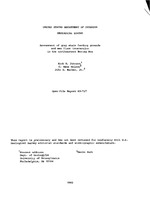A dense ampeliscid amphipod community in Chirikov Basin and around St. Lawrence Island in the northeastern Bering Sea has been outlined by summarizing biological studies, analyzing bioturbation in sediment samples, and examining sea floor photos and videotapes. The amphipod population is associated with a homogeneous, relict fine-grained sand body 0.10-1.5 m thick that is deposited during the marine transgression over the Bering land bridge 8,000-10,000 yr B.P. Modern current and water mass movements and perhaps whale feeding activity prevent modern deposition in this area.
The distribution of the transgressive sand sheet, associated amphipod community and feeding gray whales mapped by aerial survey correlate closely with three types of sea-floor pits observed on high (500 kHz) and low (105 kHz) resolution side-scan sonar; they are attributed to gray whale feeding traces and their subsequent current scour modification. The fresh and modified feeding pits are present in 22,000 km2 of the basin and they cover a total of 2 to 18% of the sea floor in different areas of the feeding region. The smallest size class of pits approximates whale mouth gape size and is assumed to represent fresh whale feeding pits. Fresh feeding disturbance of the sea floor is estimated to average about 5.7% for a full feeding season. Combined with information that 34% of the measured benthic biomass is amphipod prey species, and calculating the number of gray whale feeding days in the Alaskan waters plus amount consumed per day, it can be estimated that Chirikov Basin, 2% of the feeding area, supplies a minimum of 5.3 to 7.1% of the gray whale's food resource in the Bering Sea and Arctic Ocean. If a maximum of 50% of the fresh feeding features are assumed to be missed because they parallel side-scan beam paths, then a maximum whale food resource of 14.2% is possible in northeastern Bering Sea. Because of side-scan techniques and possible higher amphipod biomass estimates, a reasonable minimum estimate of the total whale food resource in northeastern Bering Sea is 10%.
These data show that side-scan sonar is a powerful new technique for analyzing marine mammal benthic feeding grounds. Sonographs reveal that the gray whales profoundly disturb the substrate and initiate substantial further erosion by bottom currents, all of which enhances productivity of the prey species and results in a 'farming of the sea floor'. In turn, because of the high concentration of whale prey species in a prime feeding ground that is vulnerable to the development of petroleum and mining for sand, great care is required in the exploitation of these resources in the Chirikov Basin.


